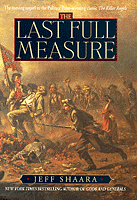|
Introduction
Chapter One
Chronology
About Jeff Shaara
An interview
with Jeff Shaara
ORDER THE
HARDCOVER
ORDER THE
PAPERBACK
ORDER THE
AUDIOBOOK
|

|

A Chronology of Major Historical Events in The Last Full Measure
July 1863: The Potomac River, Maryland
After the rebel disaster at Gettysburg, Confederate General Robert E. Lee
leads his beaten army south, back into Virginia, where the war must
inevitably continue on his own home ground.
November 1863: Bristoe Station, Virginia
Confederate General A.P. Hill recklessly exposes his troops to a
disastrous defeat, thus bringing home to Lee how much his army misses the
leadership of so many who have been lost, including Stonewall Jackson.
March 1864: Washington, D.C.
After great success leading the Federal army in the West, General Ulysses
S. Grant is selected by President Lincoln to command the entire Federal
army. He moves his headquarters to Virginia, where, for the first time,
he will confront the rebels led by Robert E. Lee.
May 1864: The Wilderness, West of Fredericksburg, Virginia
Grant pushes his great army southward to confront Lee, resulting in the
Battle of the Wilderness, a costly and bloody stalemate that many see as
Grant's first test. Lee's most reliable commander, James Longstreet, is
severely wounded and will not return to action for eight months, weakening
Lee's command even further.
May 1864: Spotsylvania Courthouse, Virginia
In one of the bloodiest battles of the war, Grant again pushes hard into
Lee's army, forcing the rebels to retreat farther south, ever closer to
Richmond. After the horrible carnage at Spotsylvania, both sides come to
understand that this will never again be a "gentleman's" war.
May 1864: Near Yellow Tavern, Virginia
The eyes of Lee's army, the dashing and colorful horse soldier Jeb Stuart,
is killed in his first major confrontation with the new Federal cavalry
commander, Phil Sheridan. It is a devastating loss for Lee.
June 1864: Cold Harbor, near Richmond, Virginia
Grant hurls his army against Lee's entrenched soldiers in a reckless
assault that costs the Federal army over eight thousand men in a fight
that lasts only minutes. It is clearly Grant's worst day as a commander.
June 1864: The James River, below Richmond, Virginia
Grant moves his entire army south, crossing the river and moving beyond
Richmond to threaten the South's valuable rail city of Petersburg. Grant
now understands that starving Lee's army by cutting off his supplies may
be the most effective way of ending the war.
July 1864: Near Petersburg, Virginia
Led by a coal miner named Henry Pleasants, the Federals accomplish an
amazing engineering feat, constructing a tunnel 400 feet underground to
reach the rebel lines. Once complete, the end of the tunnel is then
detonated, creating a monstrous explosion that leaves a wide gap in the
stunned rebel line. But poor planning and leadership in the field result
in Federal soldiers trapping themselves in the great open pit, and the
Battle of the Crater becomes another Federal disaster.
September 1864: Atlanta, Georgia
As General William T. Sherman's Federal army presses close to Atlanta,
Confederate General Joseph Johnston is removed by a frustrated Jefferson
Davis, who believes Johnston could have done more to keep Sherman at bay.
Johnston's replacement is the aggressive John Bell Hood, who proceeds to
throw his army at Sherman's much stronger force. The resulting defeats
for Hood allow Sherman to capture the critically important southern city.
November 1864: City Point, Virginia
Grant receives word that President Lincoln has been re-elected, a source
of great joy and relief for Grant and the Federal army. It means that
Grant will continue to have the government's support in ending the war by
the aggressive pursuit of Lee's army.
Christmas 1864: Petersburg, Virginia
While Lee's starving army huddles in the mud and sickness of the dismal
trenchworks, Grant receives word of Sherman's successful March to the Sea,
which has cut off the Deep South from supporting Lee. Grant know that
Lee's defeat is only a matter of time.
February 1865: City Point, Virginia
A three-man Peace Commission from the Confederate government journeys
through the lines of the armies to meet with Lincoln over the issue of
ending the war. Despite the wave of optimism that spreads through the
troops, the Confederate representatives must adhere to the policies of
Jefferson Davis, and cannot agree to anything other than the independence
of the southern states. The meeting accomplishes little, and Lincoln
instructs Grant to continue his own policies of pursuing Lee.
March 25, 1865: Near Petersburg, Virginia
Confederate General John B. Gordon launches a surprise assault on the
Federal Fort Stedman, a plan borne of desperation one final push against
Grant's strength. The attack fails, and Lee must now accept that staying
at Petersburg means the slow death of his army.
March 29, 1864: West of Petersburg, Virginia
Federal General Joshua L. Chamberlain leads his troops against Lee's right
flank in a fight along the White Oak Road. Lee's lines hold, but
Chamberlain's heroism causes Lee to spread his thin defenses even further,
weakening his lines to near-breaking point.
April 2, 1865: Petersburg, Virginia
Grant's forces make one great push all along Lee's defenses, and Lee's
lines around Petersburg begin to collapse. Lee's most able surviving
commander, General A.P. Hill, is killed.
April 3, 1865: Five Forks, Virginia
Lee's far fight flank, commanded by George Pickett, is crushed by Sheridan
and the Federal Fifth Corps, including Joshua Chamberlain. Lee
understands that he has no choice now but to pull away from Petersburg,
taking his army overland in a desperate attempt to escape Grant's
tightening grip. While attending a church service in Richmond, Jefferson
Davis receives word from Lee that Richmond can no longer be defended and
is to be evacuated.
April 4, 1865: Amelia Courthouse, Virginia
What remains of Lee's starving and battered army unites again at the rail
center of this small town, expecting much-needed food. Instead, Lee finds
rail cars stocked high with gunpowder and ammunition. He can continue to
make war, but he cannot feed his army.
April 6, 1865: Saylor's Creek, Virginia
The final large-scale fight of the war results in the capture of nearly
ten thousand of Lee's remaining troops, men who are too weak to resist the
Federal pursuit. Lee now continues the fight with an even smaller force,
and makes a last dash toward the rail center at Appomattox.
April 9, 1865: Appomattox Courthouse, Virginia
Grant's army wins the race for the critical rail junction, and Lee is
virtually surrounded by a force nearly ten times his own. Responding to
letters from Grant, Lee offers to meet with the Federal commander to
discuss terms of the surrender of Lee's army. At a private residence, the
two men meet face to face and Lee signs the paper that ends the war in
Virginia.
April 12, 1865: Appomattox Courthouse, Virginia
General Joshua L. Chamberlain is chosen by Grant to receive the official
surrender of Lee's army, a ceremony at which the rebels must deliver their
guns and flags to their enemy. Chamberlain orders his men to salute the
rebels.
April 14, 1865: Near Philadelphia, Pennsylvania
On his way to his new home to see his children for the first time in
months, Grant receives a wire informing him of the assassination of
President Lincoln.
|

